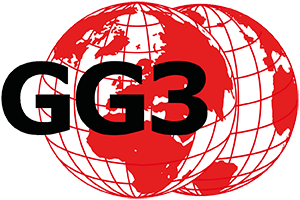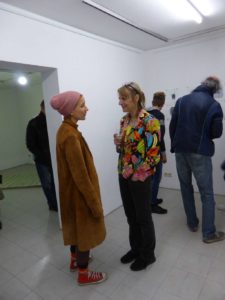Introduction to the exhibition The Song of Vanishing Species by Dr. Carola Muysers . Bees & Butterflies. Agency for creative companies
27.04.-22.06.2018. Group Global 3000, Gallery for Art and Sustainability, vertr. by Tom Albrecht, Leuschner Damm 19, 10999 Berlin.
The industrialization of agriculture with its harmful fertilizers and weed poisons threatens biodiversity across the board. The colorful animal and plant world is dwindling, biodiversity is declining, and even entire species are disappearing from our planet. Their swan song has begun.
Even if the environmental, nature, animal and landscape conservationists warn, even if statistics of species extinction are available and petitions are negotiated at all levels of politics – few hear the song of the disappearing species, few see them take their leave. And very few see the fatal consequences for humanity.
The artists Alfred Banze, Sandra Becker, Lioba von den Driesch, Stephan Groß, Sylvia Anais Krüger, Benna Gaean Maris, Sybille Neumeyer and the artistsnetwork Magenta direct now in the current group exhibition of the gallery Group Global 3000 focus their attention exactly on this topic. Their Installations, drawing, audio and video pieces as well as photo collages and objects give the phenomenon of species extinction a visual, acoustic and haptic shape. The resulting works form a new Art-language, they equip our cultural memory with a a newn artisticn vocabulary.
In her audio tracks, Italian artist Benna Gaean Maris mixes animal sounds with words and vocals. In “Evergreen ” the chirping of exotic birds sounds as if from the depths of the jungle, which crosses with oldie hits sung by the artist. The technical distortion provides over a primeval thunder and a sound carpet of familiar, strange and threatening sequences is created. Associations with creation, evolution and the culture of mankind are awakened. We begin to listen into the story.
The audio track Dying for Selfies (dedicated to baby dolphins) is dedicated to the death of a baby dolphin in Spain. Beachgoers had repeatedly taken it out of the water for selfies, clumsily cutting off its air supply and causing it such turmoil that it subsequently died. Here dolphin calls combine with the artist’s pronounced pun Selfish. The sound tapestry becomes a lament that one would like to hear as an installation at the scene.
Media artist Sandra Becker, who specializes in the artistic exploration of concrete phenomena as well as societal and social contexts, is participating this time with a small lab entitled “Birds 2018.” Here we can look at studies of flight paths and formations, as well as index cards from a small box containing Wikipedia entries of extinct bird species. Digitally distorted birdcalls sound from a loudspeaker. The installation is like a cutout of her studio, where species extinction is artistically explored. The aesthetics of the trajectories, the alienated bird sounds and the small floating card box are in contrast to the frightening figures of bird death: in Germany, there have been 12.7 million fewer breeding pairs of birds since 2006.
Installation artist Sylvia Krüger has built a cornucopia of sturdy sisal that floats above the ground. A cornucopia that should actually give the life-giving honey and flowers under the title “Whispering honey”. Instead, it provides a home for 100s of specially collected dead bees. The cornucopia has a lump on the side made of dried grasses and flowers, which also has dead bees caught in it. The cornucopia as a symbol of nature, is sick. The process of donating, pollinating, growing and passing on is disrupted, even reversed. Instead of giving life, the cornucopia has become a burial place. It is hardly clearer to say that there is something wrong with nature here and that the perpetrators are ourselves.
The Greek artist network Magenta, with the main protagonists visual artist Katerina Sotiriou and set and costume designer Elena Timplalexi, shows in its video “Unstill Life – Exquisite Corpse” a lily flower that is heated in an oven and fades. At the center of Magenta’s art work is the theme of life and death. The associated projects explore life and death with a specially developed artistic vocabulary that allows for profound interpretations. Here it is the death of plants that the artists stage in the casing of the oven as if in a showcase. The oven in which the lily, a significant plant in the history of art, opens for me an even more gruesome association: the Kzhafte destruction of life in any form.
In his collage print “Frozen Warnings,” graphic, installation, and collage artist Stephan Gross combines the motif of two flamingos on a sheet of ice with that of a young boy, a victim of war. A blanket serves as a small shelter for the boy and the flamingos. It combines the two completely different elements. The rough print screening of the collage allows a new image to emerge: the boy rests on the ice together with the flamingos, like them he is wounded or dead, and like them he is exposed to the icy cold. The new image glows in ice cream or advertising colors: pink, white, blue, pink and purple. In its beauty it asks at the same time about the vulnerability of living beings, about life and death, about those responsible for this scenario. As the title says, the image is intended as a visually memorable warning without the raised forefinger to which we have long since ceased to respond.
With their several 1,000 Bees in a light box has Artist Sybille Neumeyer the “song for the last queen” composed. The bees sind fixed individually in a glass tube filled with acacia honey and placed in the box. The animal carcasses are part of a Sheet of musics, ait Glass windows, ar Studiesshowcase, in front of which we amazed stop. To then start with the Dying one of the most threatened Animalarten in our ecosystem To be confrontedthat we possibly can no longer be averted.
For the installation “field”, the artist lets the plant motif grow up from numerous 1-dollar bills, which she has finely cut out beforehand. The artist earned the dollar bills independently growing vegetables. A monoculture paid for with dollar bills that fascinates us in its beauty, only to confront us with a massive agricultural problem when we look at it reflectively.
In his large-format drawing “Seaweed,” artist Alfred Banze has captured numerous clumps of seaweed in ink and watercolor. From delicategreen lines and black dots spread the individual kelpÄstches across the entire image area. You follow their own rhythm, jach stalk meanders in its own direction. For those who look longer, a sense of depth is created., in which the pieces like like fragmented chromosomes swim away. With his drawingnung: Beauty – Not Made for Humankind (Seaweed) will us the draftsman, media artist and performer via our functionalizeds Nature- and beautyunderstandingexecute, which gives us exclusively according to benefit and profit lets look. How beautiful calligraphy of the kelp in the water can be seen only the one that has its profitableiving view.
Media artist Lioba van den Driesch shows animations of birds, insects and frogs in her stopmotion. The water drawings on a slate capture the animals as shadows that form, fly, swim, and perish in the drying process. The retro nature of the three short films gives us insight into a world of diversity as it once was. In the time of such films, I think of Lotte Reiniger, the great animation artist and predecessor of Walt Disney.
The exhibition “the song of disappearing species” demonstrates responsibilities on many levels.
In terms of content, the art objects call for an end to the insanity of the systematic destruction of species and nature.
Then, on the aesthetic level, they demand attentiveness; you have to look, listen, read, and turn on your brain to unlock the works and their message.
And the artists present their art within the framework of a network, where everyone adheres to the idea of a better way of dealing with nature.
Finally, the gallery “Group Global” is a place where the artistic appeals to sustainability are heard, loud and spread.
The song of the vanishing species is louder than we think. Let’s join in and make it the song of a world worth living in again.
Berlin, 27.04.2018
© Dr. Carola Muysers, Agency “Bees & Butterflies”, Gitschiner Str. 61, 10969 Berlin. For use as exhibition text, for the GG3 website, for guided tours in the exhibition and for a publication on the exhibition. Other uses require coordination with the author.

